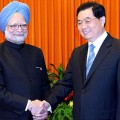
India’s Foreign Minister Manmohan Singh and China’s Xi Jinping. Credit: thediplomat.com
India is the world’s most populous democracy, an important US trading partner, and a key counterweight to China. Despite all that, there is little discussion or acknowledgement of India’s increasingly vital role in geopolitics.
That may soon change. The Center for Strategic and International Studies (CSIS) reports that the foreign policy and defense leadership of the two nations will meet in September, at a conference known as the “2+2 Dialogue.”
Last October, then-Secretary of State Rex Tillerson, addressing a CSIS gathering, noted that “Our defense ties are growing. We are coordinating our counterterrorism efforts more than ever before. And earlier this month, a shipment of American crude oil arrived in India, a tangible illustration of our expanding energy cooperation.”
Bilateral trade has expanded from $45 billion in 2006 to over $114 billion in 2016. Experts believe there is still room for vast growth.
The two nations share concerns about China’s unfair trade practices. Kenneth Rapoza wrote in Forbes that “China is dumping products in India…As the trade war goes on unabated, China’s trade practices in India — of selling its oversupply to another country, depressing prices and hurting native manufacturing — stand as a testament to Beijing’s unwavering position on global trade…In India, a government committee said Chinese imports were ‘hitting Indian industry hard and causing unemployment.’…The report also expressed concern about India’s widening trade deficit with China… Just as trade is bringing the United States and India together economically, China’s military actions are bringing them together strategically. Sales of U.S. military equipment to India have gone from zero to $15 billion in ten years. Already, the United States sells India transport and maritime patrol aircraft, anti-ship missiles, and helicopters. But, with the declaration of India as a ‘major defense partner’ in 2016, the administration can offer even more systems for sale, such as drone and fighter aircraft and aircraft-carrier technologies.”
During a visit by Prime Minister Modi to Washington on June 26, 2017, The White House enumerated the growing cooperation between the two nations, which include the U.S. providing India with advanced military technology, joint anti-terrorism efforts, increased trade (Two-way trade in goods and services reached $114 billion in 2016), and significant energy cooperation. Washington and New Delhi are also working together on some space exploration goals, developing Afghanistan’s economy, promoting agricultural advancement, and peacekeeping efforts in Africa.
Despite the optimism, rhetoric, and some shared interest, there are a number of issues that constrain a more rapid pace of Indian-American relations. Monish Tourangbam, writing for The Diplomat, stressed that:
“The India-U.S. relationship is an intriguing one in the sense that the two countries have never been adversaries, nor have they been brothers in arms…India’s decision to buy the Russian made S-400 missile defense system despite threats of American … is yet another case where Washington’s priorities clash, even if unintentionally, with India’s interests. … How the United States perceives threats from countries like Iran and Russia might not align with India’s own perceptions, creating tensions in the relationship over which New Delhi has limited control.”
In a New Republic article, Atman Trivedi emphasized that “As a recent U.S. ambassador to India acknowledged, the [Indian-American] relationship has been ‘slightly underperforming’ for decades… the hard reality is that Washington’s expectations don’t always line up with India’s current military, diplomatic, and economic circumstances. Unless the partners can pick up the pace in response to tectonic regional and global power shifts, the grand partnership imagined in the early aughts will fall short.”
A World Finance analysis notes that “Although China and India are neighbours, they are also economic rivals…Territorial issues between the two countries persist in the Aksai Chin and Arunachal Pradesh regions. Although some view India’s growing military and economic strength as a counterbalance to Chinese regional power, Beijing views it as a provocation.”
Frank Vernuccio serves as editor-in-chief of the New York Analysis of Policy and Government.














Follow Us